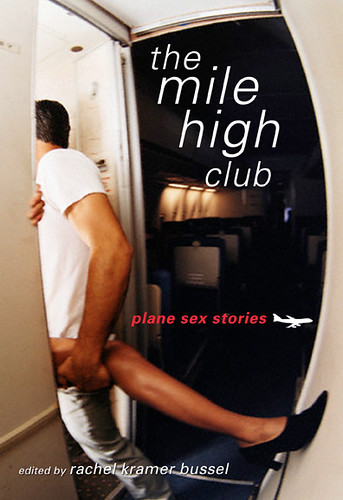
Image: cover of Rachel Kramer Bussel‘s upcoming book, Mile High Club: Plane Sex Stories.
I first started getting links sent to me around the 10th about AA and Delta agreeing to filter porn from their in-flight wi-fi, and I just sort of shrugged and goraned and gnashed my teeth a little — until I started digging into the story behind it, and the people involved. Five days later it became this week’s SF Chronicle column, Flying The Anti-Porn Skies: Violet Blue wants to know, if airline Wi-Fi is censored, who wants it? I’m pretty proud of it, and there are some revelations in it — here’s a snip:
Getting ready for my latest flight out of SFO, I ran down my checklist of must-have carry-on items in my bag. For the long flight to Los Angeles, I’d need a 16 oz. bottle of Liquid Silk, latex gloves, my raincoat, my Vibrating Hugh Jackman Realistic Dong, a pack of ten C batteries, my trusty fur-lined leopard ankle cuffs, and a blindfold. The blindfold was for napping. Since my airline now sells in-flight Wi-Fi, I could add my laptop to the list, eschew all the DVDs I usually lug on the plane, and instead of watching “Penetration Impossible #4,” I’d be flying the friendly skies crammed between my seat-mates and cruising the latest videos uploaded to YouPorn.com. After checking my e-mail, Twittering a complaint about the overpriced Wi-Fi, doing a guest blog post for Laughing Squid about the overpriced Wi-Fi and watching the Dow have another bipolar episode, of course.
I am a porn consumer. And from San Francisco, it’s like a double-whammy of pervery; everyone knows we porn users just can’t control ourselves. Thank goodness the airlines – despite having no complaints of porn being accessed over their new Wi-Fi services – are preemptively blocking and blacklisting Web sites. Otherwise, my flight would be a trip to hell in the skies for everyone sitting next to one of us porn watchers, because, you know, all that online porn consumption makes us into drooling lunatics who no longer know right from wrong.
At least that seems to be the logic when you peel back the layer of reason behind American Airlines’ recent decision to reverse their originally stated no-filtering policy for in-flight Wi-Fi and announce that they’ll be implementing “technology” to filter pornographic content over its Gogo Internet service. Seeing that on the Gogo Web site they also have Air Canada, Delta and Virgin Airlines listed as upcoming partners, we can expect to be nannied from here to Internet infinity so no one in the seats behind you have to tell you to turn down the volume on your VoD stream of “White Men Can’t Hump.” Which, if you’ve seen it, gives new meaning to the concept of “red eye flight.”
Despite the fact that there haven’t been any complaints thus far, the Association of Flight Attendants is hailing the decision they see as one less thing they have to police on board, and it makes sense – until you think about the fact that people can have and view porn on their computers even without access to the evil scary child-eating unfiltered Internet, or a European fashion magazine could have more exposed sexy nipples than erosblog.com and thesexcarnival.com rubbed together. Or that someone might – gasp! – read a book. One with sexual or pornographic content. There are so few of those out there. At least we can rest easy on our “comfortable flight” safe in the knowledge that no one reads books anymore.
Poking holes in filtering Internet Wi-Fi access as a strategy to prevent in-flight inappropriateness is easy enough, but looking at the implementation of Wi-Fi censorware will make even the sweetest sexy librarian want to throw the book at the Association of Flight Attendants. (…read more!)
Update: Praemedia just sent me this new quick Gizmodo item — Which Airlines Block Porn on In-Flight Wi-Fi (and Which Don’t). Let’s just say that MSNBC’s take on it today is a bit dryer than mine.





Should have included this. Has St. Bernard and other shit:
The Digital Marginalization of Sex
http://www.comstockfilms.com/blog/tony/2007/05/24/comstock-films-filmography-on-imdb-the-digital-marginalization-of-sex/
Even KQED has censorware installed that prevents their journalists from seeing sites like Tinynibbles.com, Erosblog.com. I tracked this back to the company that makes the “filtering” software that KQED uses and found out the default setting are what the censorware company deems are appropriate for a third grader.
This censorware is installed on hundreds of university networks around the country. Of course this software is sold as “plug and play”, meaning that most sys admins never tweek the “censorship settings”. I’d like to know what level of censorship is appropriate on a university campus.